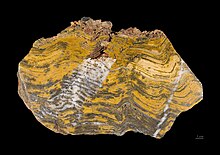
Back Stromatoliet Afrikaans ستروماتوليت Arabic Страматаліты Byelorussian Строматолит Bulgarian Estromatòlit Catalan Stromatolit Czech Stromatolit Danish Stromatolith German Στρωματόλιθος Greek Stromatolito Esperanto


Stromatolites (/stroʊˈmætəˌlaɪts, strə-/ stroh-MAT-ə-lytes, strə-)[2][3] or stromatoliths (from Ancient Greek στρῶμα (strôma), GEN στρώματος (strṓmatos) 'layer, stratum', and λίθος (líthos) 'rock')[4] are layered sedimentary formations (microbialite) that are created mainly by photosynthetic microorganisms such as cyanobacteria, sulfate-reducing bacteria, and Pseudomonadota (formerly proteobacteria). These microorganisms produce adhesive compounds that cement sand and other rocky materials to form mineral "microbial mats". In turn, these mats build up layer by layer, growing gradually over time.[5][6]
This process generates the characteristic lamination of stromatolites, a feature that is hard to interpret, in terms of its temporal and environmental significance.[7][8] Different styles of stromatolite lamination have been described,[9][10] which can be studied through microscopic and mathematical methods.[10] A stromatolite may grow to a meter or more.[11][12] Fossilized stromatolites provide important records of some of the most ancient life. As of the Holocene, living forms are rare.
- ^ Duda, J-P.; Van Kranendonk, M.J.; Thiel, V.; Ionescu, D.; Strauss, H.; Schäfer, N.; Reitner, J. (2016). "A Rare Glimpse of Paleoarchean Life: Geobiology of an Exceptionally Preserved Microbial Mat Facies from the 3.4 Ga Strelley Pool Formation, Western Australia". PLOS One. 11 (1): e0147629. Bibcode:2016PLoSO..1147629D. doi:10.1371/journal.pone.0147629. PMC 4726515. PMID 26807732.
- ^ "stromatolite". Merriam-Webster.com Dictionary. Retrieved 21 January 2016.
- ^ "stromatolite". Lexico UK English Dictionary. Oxford University Press. Archived from the original on 17 June 2020.
- ^ στρῶμα, λίθος. Liddell, Henry George; Scott, Robert; A Greek–English Lexicon at the Perseus Project.
- ^ Winner, Cherie (15 November 2013). "What Doomed the Stromatolites?". Woods Hole Oceanographic Institution.
- ^ "Two-ton, 500 Million-year-old Fossil Of Stromatolite Discovered In Virginia, U.S." 8 July 2008.
- ^ Seong-Joo, Lee; Browne, Kathleen M.; Golubic, Stjepko (2000), Riding, Robert E.; Awramik, Stanley M. (eds.), "On Stromatolite Lamination", Microbial Sediments, Berlin, Heidelberg: Springer Berlin Heidelberg, pp. 16–24, doi:10.1007/978-3-662-04036-2_3, ISBN 978-3-642-08275-7, retrieved 9 February 2024
- ^ Arenas, Concha; Jones, Brian (October 2017). Hollis, Cathy (ed.). "Temporal and environmental significance of microbial lamination: Insights from Recent fluvial stromatolites in the River Piedra, Spain". Sedimentology. 64 (6): 1597–1629. doi:10.1111/sed.12365. ISSN 0037-0746.
- ^ Monty, C.L.V. (1976), "Chapter 5.1 The Origin and Development of Cryptalgal Fabrics", Developments in Sedimentology, vol. 20, Elsevier, pp. 193–249, doi:10.1016/s0070-4571(08)71137-3, ISBN 978-0-444-41376-5, retrieved 9 February 2024
- ^ a b Suarez-Gonzalez, Pablo; Quijada, I. Emma; Benito, M. Isabel; Mas, Ramón; Merinero, Raúl; Riding, Robert (March 2014). "Origin and significance of lamination in Lower Cretaceous stromatolites and proposal for a quantitative approach". Sedimentary Geology. 300: 11–27. doi:10.1016/j.sedgeo.2013.11.003.
- ^ "Stromatolites". Indiana University Bloomington. Archived from the original on 19 March 2018. Retrieved 14 May 2018.
{{cite web}}: CS1 maint: bot: original URL status unknown (link) - ^ Riding, R. (2007). "The term stromatolite: towards an essential definition". Lethaia. 32 (4): 321–30. doi:10.1111/j.1502-3931.1999.tb00550.x. Archived from the original on 2 May 2015.
© MMXXIII Rich X Search. We shall prevail. All rights reserved. Rich X Search